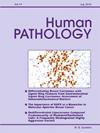Female reproductive tract inflammatory myofibroblastic tumor (IMT): A comprehensive analysis of clinicopathological and genomic features in a case series, including the identification of SERPINE1-ALK fusion in the fallopian tube
IF 2.6
2区 医学
Q2 PATHOLOGY
引用次数: 0
Abstract
Inflammatory myofibroblastic tumors (IMTs) of the female reproductive tract are rare neoplasms, predominantly originating in the uterus, but can occasionally be identified in other locations. This retrospective study included 15 cases from six hospitals in China between 2017 and 2024, comprising 14 cases involving the uterus and one involving a fallopian tube. DNA and RNA next-generation sequencing (NGS) was conducted on all samples. The age of onset ranged from 34 to 54 years, with a median of 41 years and a mean of 42.40 ± 1.32 years. Tumor sizes varied from 2.9 cm to 10.0 cm, with a median size of 6.00 cm and a mean size of 5.90 ± 0.45 cm. RNA sequencing demonstrated ALK rearrangements with either identical or distinct fusion partners in individual cases, including a new partner, SERPINE1, detected in the case involving the fallopian tube. DNA sequencing revealed that 46.7 % (7/15) of the cases exhibited additional gene mutations, including one case with a TP53 mutation that had been previously reported and subsequently developed metastasis within a few months. ALK rearrangement remains the primary driver gene and therapeutic target for this type of tumor. From the perspective of predicting tumor biology, genetic variations at the DNA level, in addition to clinicopathological parameters, are equally significant and may provide a critical foundation for prognosis.
女性生殖道炎症性肌纤维母细胞瘤(IMT):临床病理和基因组特征的综合分析,包括输卵管SERPINE1-ALK融合的鉴定。
女性生殖道炎症性肌纤维母细胞瘤(IMTs)是一种罕见的肿瘤,主要起源于子宫,但偶尔也可以在其他部位发现。本回顾性研究纳入了2017年至2024年中国6家医院的15例病例,其中14例涉及子宫,1例涉及输卵管。对所有样品进行DNA和RNA下一代测序(NGS)。发病年龄34 ~ 54岁,中位41岁,平均42.40±1.32岁。肿瘤大小为2.9 ~ 10.0 cm,中位大小为6.00 cm,平均大小为5.90±0.45 cm。RNA测序显示,在个别病例中,ALK重排与相同或不同的融合伴侣,包括在涉及输卵管的病例中检测到的新伴侣SERPINE1。DNA测序显示,40%(6/15)的病例表现出额外的基因突变,包括1例先前报道的TP53突变,随后在几个月内发生转移。ALK重排仍然是这类肿瘤的主要驱动基因和治疗靶点。从预测肿瘤生物学的角度来看,DNA水平的遗传变异与临床病理参数同样重要,可能为预后提供重要的基础。
本文章由计算机程序翻译,如有差异,请以英文原文为准。
求助全文
约1分钟内获得全文
求助全文
来源期刊

Human pathology
医学-病理学
CiteScore
5.30
自引率
6.10%
发文量
206
审稿时长
21 days
期刊介绍:
Human Pathology is designed to bring information of clinicopathologic significance to human disease to the laboratory and clinical physician. It presents information drawn from morphologic and clinical laboratory studies with direct relevance to the understanding of human diseases. Papers published concern morphologic and clinicopathologic observations, reviews of diseases, analyses of problems in pathology, significant collections of case material and advances in concepts or techniques of value in the analysis and diagnosis of disease. Theoretical and experimental pathology and molecular biology pertinent to human disease are included. This critical journal is well illustrated with exceptional reproductions of photomicrographs and microscopic anatomy.
 求助内容:
求助内容: 应助结果提醒方式:
应助结果提醒方式:


